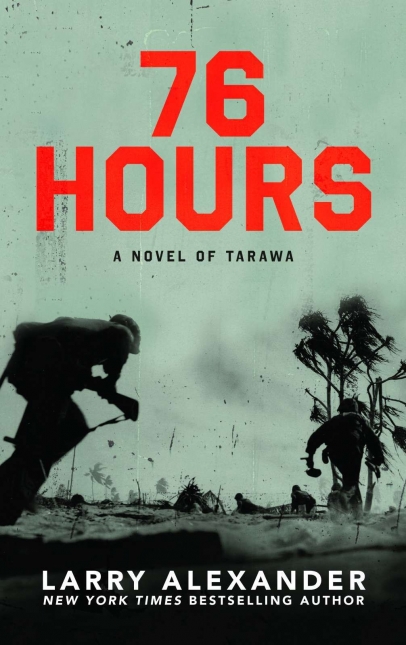76 Hours: A Novel of Tarawa
- By Larry Alexander
- Blackstone Publishing
- 324 pp.
- Reviewed by Tom Glenn
- April 7, 2023
A vivid reimagining of a real-life WWII battle.

Larry Alexander’s 76 Hours brought back memories of combat I’d rather forget. The title comes from the duration of the World War II battle of Tarawa, an atoll made up of more than 30 islets in the middle of the Pacific Ocean, that took place from November 20-23, 1943. Holding the area were between 3,000 and 5,000 Japanese soldiers; the U.S. force attacking them included some 12,000 Marines.
The Japanese defenders were thought to be invincible. According to one source, the atoll was protected by 500 pillboxes filled with artillery pieces. The Japanese commanding officer told his subordinates that it would take a million men a hundred years to conquer Tarawa. Any attackers would be slaughtered before they ever got ashore.
The principal American in the novel — it’s unclear which characters are based on real people — is Marine private Pete Talbot, a disillusioned youth who enlisted to escape his vicious father; Pete’s younger brother did the same, joining the Navy and later dying when the Japanese destroyed his submarine. Pete’s enemy counterpart is Leading Seaman Kenji Sakai. It is through the eyes of these two men that much of the story is told.
The recounting of the battle alternates between U.S. and Japanese viewpoints. As the story progresses and the Americans gain a foothold, the switching back and forth speeds up. By the end of the book, the perspective shifts occur with every paragraph.
The casualties of the real-life battle of Tarawa were horrendous. On the U.S. side, roughly 1,000 servicemen died, and more than 2,000 were wounded. On the Japanese side, only 17 survived; the dead numbered in the thousands. Many of those Japanese died by their own hand, suicide being preferable to surrender. All told, approximately 4,690 of the atoll’s defenders perished during the three-day fight.
Much of the narrative comes from the give-and-take among the U.S. Marines on one side and the Japanese soldiers on the other. The banter among the Americans felt authentic to me, based on my own experiences. The exchanges among the Japanese, however, didn’t ring true. Granted, while I worked for many years with the people of Southeast Asia (primarily in Vietnam), I spent little time in Japan. Nevertheless, I suspect men under fire converse largely the same way no matter their nationality.
Another oddity of the story — especially given the heated, frantic battle it recounts — is the occasional flash of empathy felt by the men (on both sides) for their enemy, such as here:
“Pete’s mind went back to the Japanese soldier. Even though the man’s grenade had killed Sandy and ripped up his own leg, he could not feel hatred for his enemy. Oddly, he felt a kinship with the soldier, a young man just like himself, doing the job he’d been ordered to do.”
I can’t judge the validity of this portrayal. All I can say is that I didn’t experience anything like it during my years in combat. But I can vouch for the authenticity of the depiction of combat itself. Alexander faithfully captures the feel of the battlefield, so much so that I found myself smiling cynically and nodding as the characters struggled to save a man fighting beside them, went for days without food or sleep, and accepted that they might not survive.
One of my goals in life is to get those who’ve never endured combat to understand its horror so that we, as a nation, can devote ourselves to avoiding the monstrousness of war. For that reason alone, I recommend 76 Hours.
Tom Glenn, Ph.D., spent the better part of 13 years in Vietnam assisting troops in combat with signals intelligence, and he escaped under fire when Saigon fell in April 1975. As a speaker of Vietnamese, Chinese, and French (the three languages of Vietnam), he worked during those years with many different nationalities. A linguist in seven languages, Glenn was assigned to a variety of other locations after 1975, but that work is still classified. He retired as early as he could from the government more than 30 years ago to write fiction. He now has six books and 17 short stories in print.

